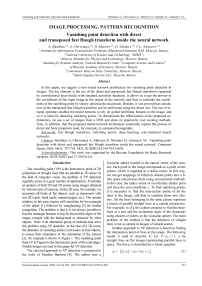Vanishing point detection with direct and transposed fast hough transform inside the neural network
Автор: Sheshkus Alexander Vladimirovich, Chirvonaya Anastasiya Nikolaevna, Matveev Daniil Mikhailovich, Nikolaev Dmitry Petrovich, Arlazarov Vladimir Lvovich
Журнал: Компьютерная оптика @computer-optics
Рубрика: Обработка изображений, распознавание образов
Статья в выпуске: 5 т.44, 2020 года.
Бесплатный доступ
In this paper, we suggest a new neural network architecture for vanishing point detection in images. The key element is the use of the direct and transposed fast Hough transforms separated by convolutional layer blocks with standard activation functions. It allows us to get the answer in the coordinates of the input image at the output of the network and thus to calculate the coordinates of the vanishing point by simply selecting the maximum. Besides, it was proved that calculation of the transposed fast Hough transform can be performed using the direct one. The use of integral operators enables the neural network to rely on global rectilinear features in the image, and so it is ideal for detecting vanishing points. To demonstrate the effectiveness of the proposed architecture, we use a set of images from a DVR and show its superiority over existing methods. Note, in addition, that the proposed neural network architecture essentially repeats the process of direct and back projection used, for example, in computed tomography.
Fast hough transform, vanishing points, deep learning, convolutional neural networks
Короткий адрес: https://sciup.org/140250045
IDR: 140250045 | DOI: 10.18287/2412-6179-CO-676
Список литературы Vanishing point detection with direct and transposed fast hough transform inside the neural network
- Skoryukina N, Nikolaev DP, Sheshkus A, Polevoy D. Real time rectangular document detection on mobile devices. Proc SPIE 2015; 9445: 94452A. DOI: 10.1117/12.2181377
- Tropin DV, Shemyakina YA, Konovalenko IA, Faradzhev IA. Localization of planar objects on the images with complex structure of projective distortion [In Russian]. Informatsionnye Protsessy 2019; 19(2): 208-229.
- Bobkov VA, Ronshin YI, Kudryashov AP. Kalibrovka izobrazheniy gorodskoy obstanovki [In Russian]. Informatsionnye Tekhnologii i Vychislitelnye Sistemy 2009; 1: 72-83.
- Barnard ST. Interpreting perspective images. Artificial Intelligence 1983; 21(4): 435-462. DOI: 10.1016/S0004-3702(83)80021-6
- Yin XC, Hao HW, Sun J, Naoi S. Robust vanishing point detection for mobile cam-based documents. Proc 7th Int Conf on Document Analysis and Recognition (ICDAR) 2011; 136-140. DOI: 10.1109/ICDAR.2011.36
- Nikolaev DP, Karpenko SM, Nikolaev IP, Nikolaev PP. Hough transform: underestimated tool in the computer vision field. Proc 22th European Conf on Modelling and Simulation (ECMS) 2008; 238-246.
- DOI: 10.7148/2008-0238
- Lutton E, Maitre H, Lopez-Krahe J. Contribution to the determination of vanishing points using Hough transform. IEEE Trans Pattern Anal Mach Intell 1994; 16(4): 430-438.
- DOI: 10.1109/34.277598
- Chen X, Jia R, Ren H, Zhang Y. A New Vanishing Point Detection Algorithm Based on Hough Transform. 2010 3rd Int Joint Conf on Computational Science and Optimization 2010; 440-443. 10.1109/CSO. 2010.163.
- DOI: 10.1109/CSO.2010.163
- Alturki AS, Loomis JS. Camera principal point estimation from vanishing points. IEEE National Aerospace and Electronics Conference (NAECON) and Ohio Innovation Summit (OIS) 2016; 307-313.
- DOI: 10.1109/NAECON.2016.7856820
- Borji A. Vanishing point detection with convolutional neural networks. Source: áhttps://arxiv.org/abs/1609.00967ñ.
- Zhai M, Workman S, Jacobs N. Detecting vanishing points using global image context in a Non-Manhattan World. IEEE Conf Comp Vis Pattern Recogn (CVPR) 2016; 5657-5665.
- DOI: 10.1109/CVPR.2016.610
- Sheshkus A, Ingacheva A, Nikolaev D. Vanishing points detection using combination of fast Hough transform and deep learning. Proc SPIE 2018; 10696: 106960H.
- DOI: 10.1117/12.2310170
- Sheshkus A, Ingacheva A, Arlazarov V, Nikolaev D. HoughNet: neural network architecture for vanishing points detection. Proc 15th Int Conf Doc Anal Recognit (ICDAR 2019) 2019; 844-849.
- DOI: 10.1109/ICDAR.2019.00140
- Fishburn P, Schwander P, Shepp L, Vanderbei RJ. The discrete Radon transform and its approximate inversion via linear programming. Discret Appl Math 1997; 75(1); 39-61.
- Syben C, Michen M, Stimpel B, Seitz S, Ploner S, Maier A. PYRO-NN: Python reconstruction operators in neural networks. Medical Physics 2019; 46(11): 5110-5115.
- DOI: 10.1002/mp.13753
- Kak AC, Slaney M. Principles of computerized tomographic imaging. New York: IEEE Press; 1988.
- Kiryati N, Bruckstein AM. Heteroscedastic Hough transform (HtHT): An efficient method for robust line fitting in the ‘errors in the variables' problem. Comput Vis Image Underst 2000; 78(1): 69-83.
- DOI: 10.1006/cviu.1999.0828
- Sheshkus A, Limonova E, Nikolaev D, Krivtsov V. Combining convolutional neural networks and Hough transform for classification of images containing lines. Proc SPIE 2017; 10341: 103411C.
- DOI: 10.1117/12.2268717
- McCulloch W, Pitts W. A logical calculus of ideas immanent in nervous activity. Bull Math Biol 1943; 4(5): 115-1334.
- DOI: 10.1007/BF02478259
- Fukushima K. Neocognitron: A self-organizing neural network model for a mechanism of pattern recognition unaffected by shift in position. Biol Cybern 1980; 4(36): 193-202.
- DOI: 10.1007/BF00344251
- Hough P. Method and means for recognizing complex patterns. IEEE Transactions on Pattern Analysis and Machine Intelligence 1962; 430-438.
- Brady ML, Yong W. Fast parallel discrete approximation algorithms for the Radon transform. Proc 4th annual ACM Symposium on Parallel Algorithms and Architectures 1992; 91-99.
- DOI: 10.1145/140901.140911
- Ershov E, Terekhin A, Nikolaev D, Postnikov V, Karpenko S. Fast Hough transform analysis: pattern deviation from line segment. Proc SPIE 2015; 9875: 987509.
- DOI: 10.1117/12.2228852
- Prun VE, Buzmakov AV, Nikolaev DP, Chukalina MV, Asadchikov VE. A computationally efficient version of the algebraic method for computer tomography. Autom Remote Control 2013; 74(10): 1670-1678.
- DOI: 10.1134/S000511791310007X
- High-performance C++/CUDA implementation of convolutional neural networks. Source: áhttps://code.google.com/p/cuda-convnet/ñ.


